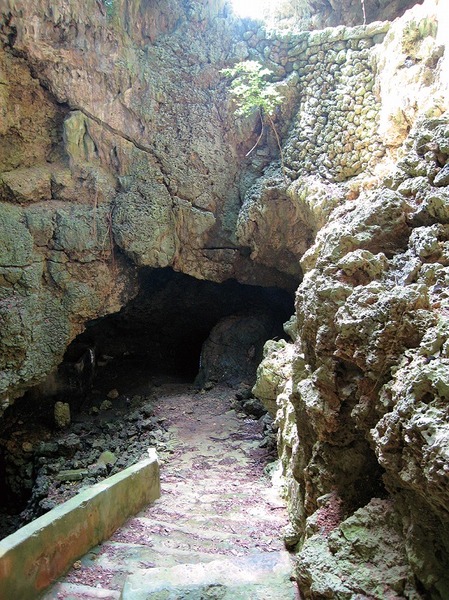トップ > 市の組織 > 教育委員会 > 生涯学習部 > 生涯学習振興課 > 【県指定:有形民俗】城辺町の友利のあま井
【県指定:有形民俗】城辺町の友利のあま井
〔ぐすくべちょうのともりのあまがー〕
城辺の字砂川と字友利の境界にあって、友利元島遺跡の西側に隣接する自然洞窟の井泉である。降り口から湧き口までの深さは約20m、自然洞窟井泉の規模としては大きく、水量も豊かである。
1965(昭和40)年に城辺で上水道が普及する以前は、この井泉が飲料水を始め、生活を営む上の貴重な水資源であった。水を汲むのは婦女子の日課で、あま井に降りる石段の側面の岩には摩滅してしまったところが数箇所あり、当時の苦労がしのばれる。
あま井について、「雍正旧記」(1727年)には「掘年数不相知」と記されている。友利・砂川・新里の各元島(旧集落)の住民が、「明和の大津波」(1771年)以前から現在地への集落移動後も長く利用した井泉である。
地域住民の水利用のあり方やその歴史的変遷を知る上でも価値の高い井泉である。
【Prefecturally Designated:Tangible Folk】Amaga of Tomori in Gusukube-Cho
This is a spring found in a natural cave on the west side of the Tomori Motojima Remains at the border of Sunagawa and Tomori in Gusukube. From the entrance of the cave to the mouth of the spring is approximately 20m and is large for a natural cave with a spring, and the water also flows abundantly.
Until the water supply was sufficiently established in Gusukube in 1965, the spring was an essential source of drinking water and for everyday life for the people in the area. Fetching water was a daily chore for the women and children, and along the sides of the stone steps, we can observe several areas where it is worn, telling us of the hardships of the past ages.
In the history book, Yoseikyuki (1727), it is written that it is unknown when the spring was dug or discovered. This spring was used by the residents of each of the Motojima of Tomori, Sunagawa, and Shinzato (former settlements) even before the Great Tsunami of Meiwa, and after the relocation of the settlements.
This spring is an important source of information to better understand the historical changes of the water use by the local residents.
【縣指定:有形民俗】城邊町友利的阿瑪井
位於城邊的字砂川和字友利的交界線上,毗鄰友利元島遺跡西側,一個自然洞穴的泉井。井口到出水口的深度約20m,在自然洞穴井泉中,屬於規模較大,水量也比較充足。
1965(昭和40)年在城邊還沒有普及水道的時候,這口泉井除了做為飲用水,還是人們維持日常生活,珍貴的水資源。打水是女性的日常工作,下到阿瑪井的石梯側面岩石有好幾處,都被磨滅了,可見當時的艱苦。關於阿瑪井,在『雍正舊記』(1727年)中,記載到「不知掘井年數」。友利、砂川、新里的各個元島(舊村落)的村民在「明和大海嘯」(1771年)之前移動到現在的地方,長期都在利用這個泉井。
阿瑪井是在瞭解各地百姓如何利用水資源及其歷史變遷上,具有極高的價值。
【오키나와현 지정:유형 민속】구스쿠베초, 도모리의 아마가 우물
구스쿠베의 아자 스나가와와 아자 도모리의 경계에 있으며, 도모리 모토지마 유적지 서쪽에 인접하는 자연 동굴샘이다. 샘의 깊이는 약 20m, 자연 동굴샘의 규모로써는 큰 편이며 수량도 풍부하다.
1965년 구스쿠베에 상수도가 보급되기 전까지 이 샘은 음료수를 비롯하여, 일상생활에 있어 소중한 수자원이었다. 물을 푸는 작업은 여성들의 일과였다. 아마가 우물에 내려가는 돌계단 측면에 있는 바위에 마멸한 곳이 몇 군데 있을 정도로 당시의 고생은 심했다. 아마가 우물에 대해서 “요세이 구기(雍正旧記, 1727년)” 에는 “언제 팠는지 알 수 없다”라고 적혀 있다. 도모리, 스나가와, 신자토의 각 마을 주민이 “메이와의 대 쓰나미”(1771년) 이전부터 현재의 위치로 마을을 이전한 후에도 오랫동안 이용했던 샘이다. 지역 주민이 어떻게 물을 이용했는지, 그 역사와 변천을 이해하는데 있어서도 가치가 높다.
生涯学習部 生涯学習振興課
電話:0980-72-3764






